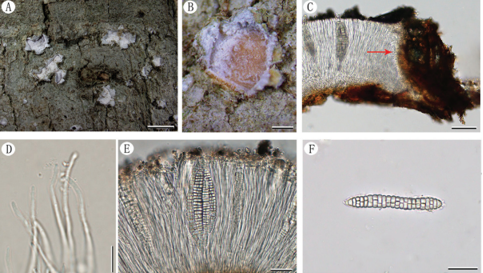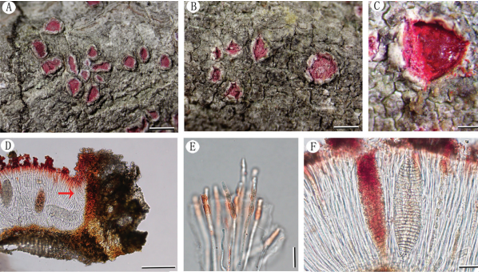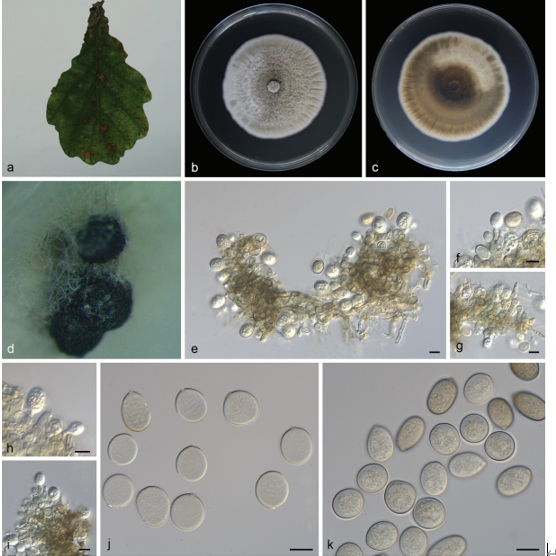Phytophthora cathayensis C. Morales-Rodríguez, Y. Wang & A. Vannini 2020
MycoBank MB834619.
Holotype: China, Zhejiang, Hangzhou, Lina, Tuankou, isolated from small pieces of cambium and adjacent xylem tissue from Carya cathayensis tree with collar canker, 2017, C. Morales-Rodríguez CP30 (holotype preserved as metabolically inactive culture, China General Microbial Culture Collection, CGMCC No. 19655; ex-type culture, CGMCC No. 19655).
Morphological description
Sporangia (Fig. 3): Papillate persistent sporangia were abundantly produced in distilled water and non-sterile soil extract 8–12 h on simple sporangiophores. Sporangia were rarely observed on solid agar. Semi-papillate sporangia were also occasionally observed. Although predominantly ovoid (90 %, Fig. 3A–C, E), various sporangial shapes were observed including ovoid, elongated ovoid, and limoniform (Fig. 3). Occasionally forming a conspicuous basal plug (Fig. 3C) that protruded into the empty sporangium. Sporangia were typically borne terminally, but some were laterally attached (Fig. 3D–E). Sporangia produced on the tips of radiating hyphae of a hyphal swelling (Fig. 3E) or with short hyphal appendices (Fig. 3B) were common. Sporangia of each isolate released zoospores between 15–20 h after flooding, zoospores were spherical and motile. Sporangia averaged 27.3 ± 4.0 μm in length and 18.6 ± 2.4 μm in breadth (full range), the average length to breadth ratio was 1.5 ± 0.1. The mean papilla dimensions were 5.3 ± 1.1 μm in length and 2.36 ± 0.6 μm in breadth, the average length to breadth ratio was 2.4 ± 0.6 μm. Chlamydospores rarely produced, on average 30.5 ± 3 μm (Fig. 3F). Oogonia, oospores, and antheridia (Fig. 3J–O): Phytophthora cathayensis is homothallic. Gametangia were readily produced in single culture by all isolates. Oogonia terminal at the main hyphae, globose to slightly subglobose with smooth walls. Mean oogonial diameter on V8A was 24.5 ± 1.6 μm (overall range 20.19–28.99 μm;). Oospores were globose with a mean diameter of 22.2 ± 1.3 μm (overall range 18.35– 25.23 μm), an average oospore wall thickness of 1.6 ± 0.2 μm, and a mean oospore wall index of 0.2 ± 0.02 (overall range 0.15– 0.26). The mean proportion of plerotic oopores was 80.66 %. The percentage of oogonial or oospore abortion was low (15 %). Antheridia mostly lateral and sessile with a short stalk, one per oogonium, attached near the stalk and rarely displaced, paragynous, cylindrical or club-shaped, averaging 11.4 ± 1.3 × 9.4 ± 1.2 μm. Isolates of P. cathayensis formed appressed to submerged colonies with a stellate growth pattern on MEA, stoloniferous felty colonies with submerged margins on PDA and uniform and slightly cottony on PARPNH (Fig. 4). On V8A colony morphology was more variable, ranging from stellate patterns to uniform pattern. Diameters of primary hyphae of P. cathayensis averaged 4.5 ± 0.7 µm and varied from 2.7 to 5.8 µm. All isolates tested had identical cardinal temperatures and similar radial growth rates at all temperatures (Fig. 5). The maximum growth temperature for P. cathayensis was 30 °C. All isolates were unable to grow at 32 °C and did not resume growth when plates previously incubated for 5 d at 32.5 °C were transferred to 25 °C. The optimum temperature for growth was 25 °C with growth rates of 10.2 ± 0.6 mm/d. At 20 °C P. cathayensis showed growth rates of 7.5 ± 0.6 mm/d on V8A, 4.6 ± 0.5 mm/d on PDA, and 5.5 ± 0.2 mm/d on MEA.
Habitat: From small pieces of cambium and adjacent xylem tissue from Carya cathayensis tree with collar canker.
Distribution: In China.
GenBank Accession:
Notes: Phytophthora cathayensis is phylogenetically related to P. litchii and P. palmivora (Fig. 2) although, morphologically, it is easily distinguishable from both species as well as from P. megakarya by having non-caducous sporangia and a homothallic mating system (Table 1). Phytophthora cathayensis produces smaller sporangia with a higher l/b ratio compared to P. alticola, P. arenaria, P. boodjera, and P. quercetorum. Terminal chlamydospores can be produced by P. cathayensis and P. quecetorum but are absent in P. alticola, P. arenaria and P. boodjera (Table 1). The diameter of the oogonium is similar to P. arenaria and smaller than in P. alticola, P. boodjera, and P. quercetorum (Table 1).
Reference: C. Morales-Rodríguez1*, Y. Wang2, D. Martignoni1 et al.
A. Ovoid papillate, laterally inserted sporangia. B. Laterally inserted sporangium with short hyphal appendice. C. Conspicuous basal plugs on empty sporangium. D. Laterally inserted semipapillate sporangium with markedly curved apex and swelling before sporangial base. E. Sporangia produced on the tips of hyphae radiating from a hyphal swelling. F. Globose chlamydospore with thin walls. G. Limoniform sporangium. H. Elongated ovoid semipapillate sporangium. I. Hyphal swelling. J. Paragynous antheridium on an immature oogonium. K. Mature oogonia with thick-walled oospore and two pellucid bodies. L. Oospore germination. M. Mature aplerotic oogonia with think walled oospore and ooplast. N. Aborted oospore. O. Aplerotic and plerotic oospores. Scale bars = 5 μm.









